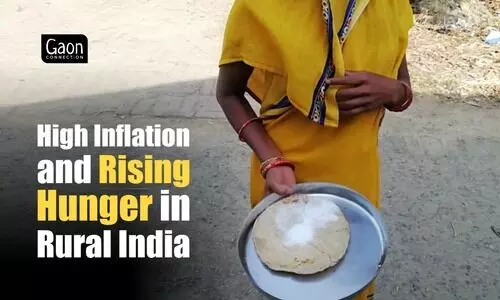Rural India is reeling under high inflation and 40-year-old Veena is finding it difficult to manage the family’s monthly budget. Her husband is the lone earning member of the family of five and his meagre monthly income of Rs 10,000 pays for their food, the house rent, electricity bill and the refilling of the LPG cylinder.
“We now stick to cooking only one sabzee [vegetable] a day. The milk we buy either goes in our chai or is consumed by kids. We cannot afford the expensive daals [pulses],” the mother of three, a resident of Ballabgarh in Haryana, told Gaon Connection. “We also have to pay our electricity bill in instalments,” she added.
About 800 kilometres away from Veena’s village, in Uttar Pradesh’s Varanasi, Rita Banwasi faces a similar ordeal. “Sometimes we eat roti with salt, sometimes we eat daal and rice, sometimes we don’t. When we won’t have anything then what will we eat?” the 40-year-old resident of Newada village asked.
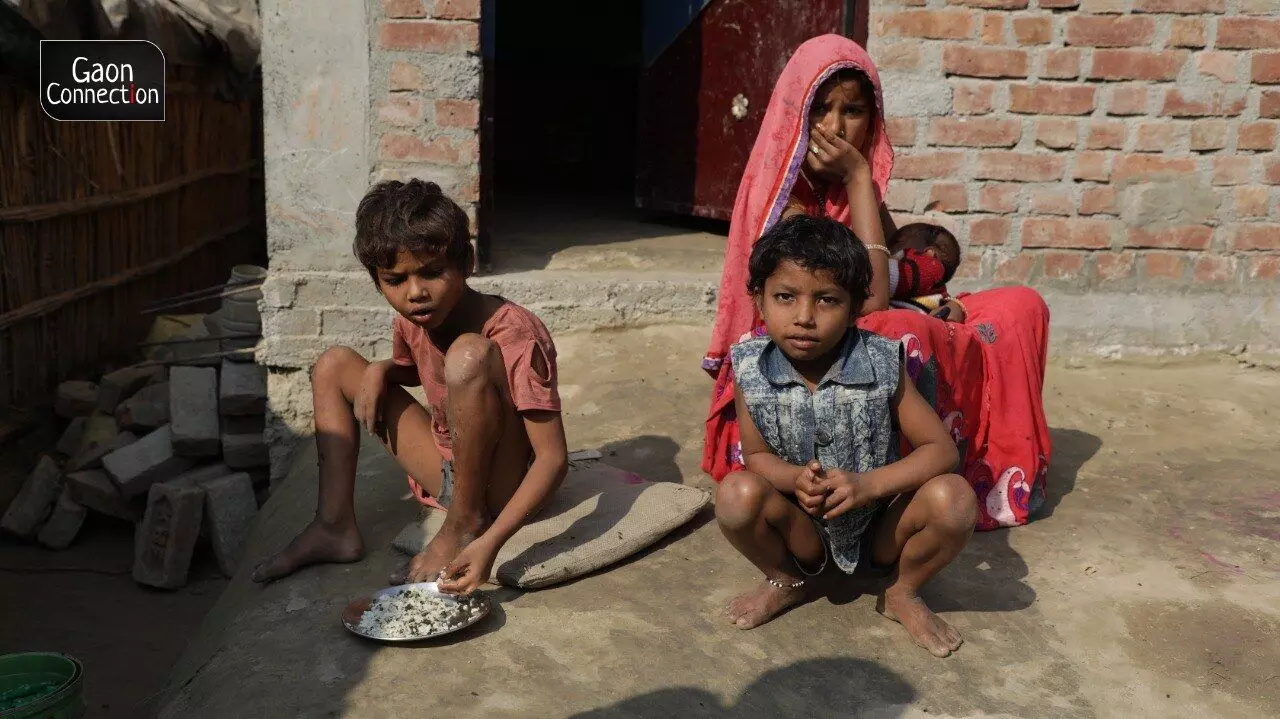
The script remains the same for Sitapur district’s Kalawati, a daily wage worker, who, on a good day, earns Rs 202 if he finds work under the MGNREGA (Mahatma Gandhi National Rural Employment Guarantee Act).
“Sometimes, I eat salt with roti and on some days when I am unable to manage salt, I make do with dried roti,” Kalawati, a resident of Maholi in Sitapur, told Gaon Connection.
Mehangai bahut badd gaye hai, is a common refrain in rural India. And the rising inflation in the past two months has led to an increase in the prices of all the essential food items.
Rising inflation in rural India
The Consumer Price Index (CPI) released yesterday, May 12, by The National Statistical Office, Ministry of Statistics and Programme Implementation highlighted that the provisional inflation rate in rural India for the month of April 2022 stood at 8.38 per cent, which was higher than in urban areas at 7.09 per cent.
The CPI is designed to measure the changes over time in the general level of retail prices of selected goods and services that households purchase for the purpose of consumption. Such changes affect the real purchasing power of consumers’ income and their welfare.
The April 2022 inflation rate of 8.38 per cent for rural India is higher than the inflation rate in the preceding month of March when it was 7.66 per cent. Compared to last year, it is a huge jump. In April 2021 the CPI was 3.75 per cent (see table: All India Inflation Rates 2022 vs 2021).
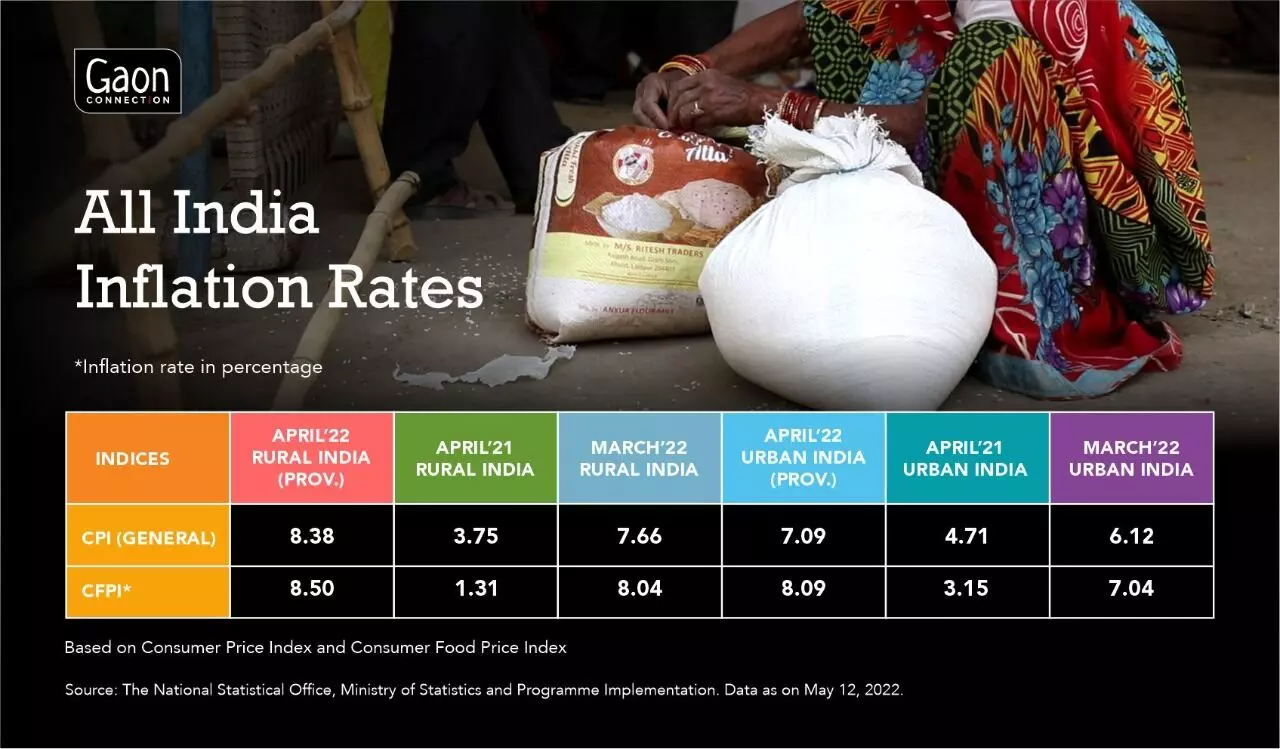
The consumer food price index (CFPI) for rural India was recorded at 8.50 per cent in April 2022. In March 2022 it was 8.04 per cent. Last year, in April 2o21, the consumer food price index was 1.31 per cent .
CFPI is a measure of change in retail prices of food products consumed by a defined population group in a given area with reference to a base year. Food is a significant part of the CPI composition followed by fuel, especially in rural CPI, which is why rural inflation is sharper than urban inflation.
“Rural CPI is very different from the urban CPI that includes the cost of housing which is not captured in the rural CPI because typically, one doesn’t live on rent in rural areas and hence the rural inflation is higher than urban population because it’s directly affected by food and fuel prices,” Abhishek Jain, Fellow and Director – Powering Livelihoods with New Delhi-based non-profit Council on Energy, Environment and Water (CEEW), India explained.

Data provided by the price monitoring cell of the Department of Consumer Affairs shows a steep rise in prices of various commodities in the past one year including edible oil such as the packed mustard and palm oil. This increase in edible oil prices can partially be attributed to the recent ban on export of palm oil by Indonesia, which was captured in an earlier report of Gaon Connection published on May 2.
Also Read: Indonesia’s palm oil export ban will affect India’s edible oil market
The ongoing Ukraine-Russia war has also affected global supply chains leading to the price rise of various food commodities.
For instance, the price of masoor dal (red lentil) has increased from Rs 84.34 a kg a year ago to Rs 96.77 as on May 9, 2022. Price of tomatoes has more than doubled in the last year from Rs 17.93 to Rs 38.26. Milk prices have jumped from Rs 47.85/litre to Rs 51.38/litre (see graphic: All India Average Retail Price)
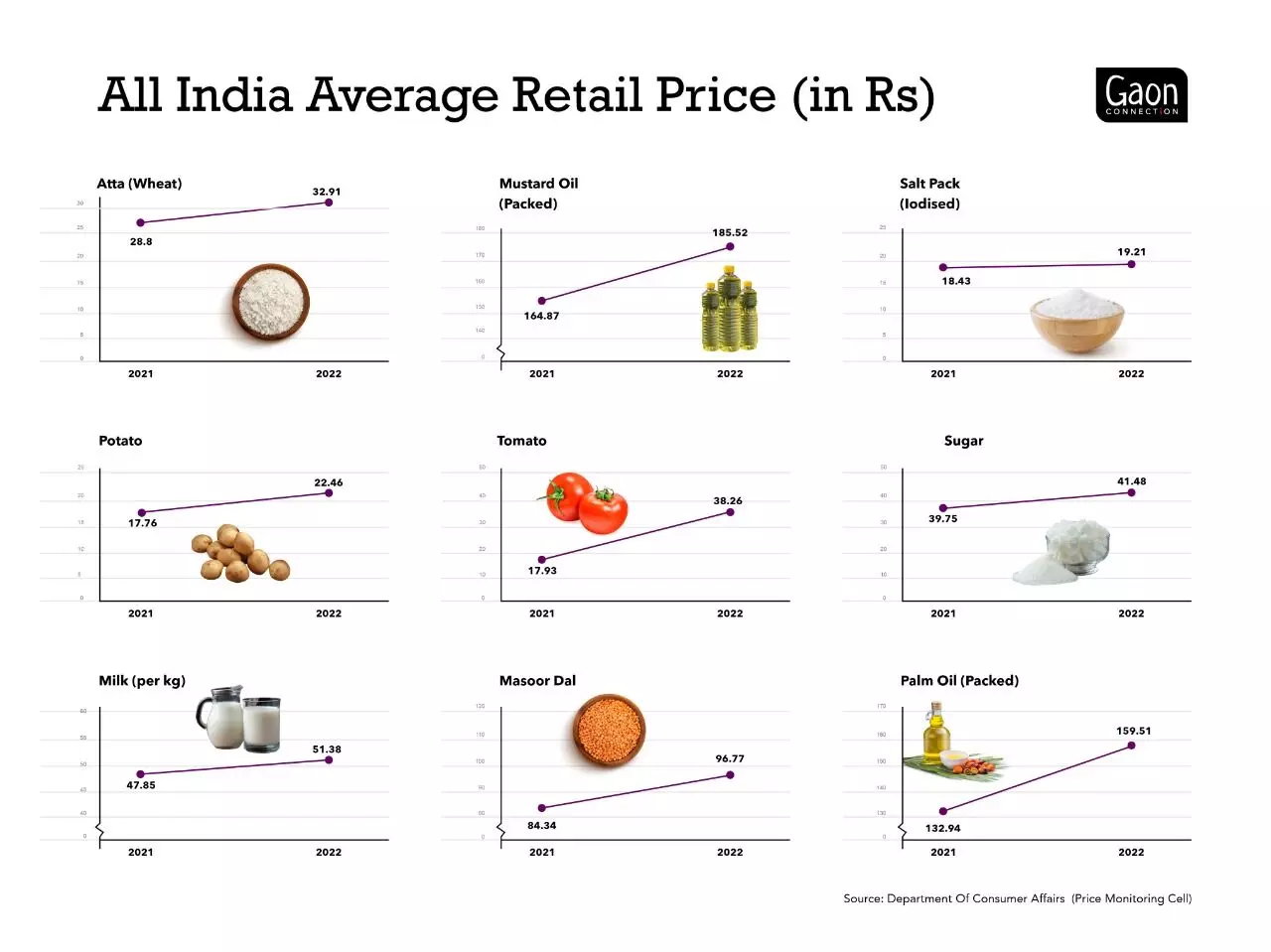
Based on the rising inflation in rural India, sector experts are raising an alarm. “Food items like vegetables and milk will be the first items that will start shedding off from the food basket in rural areas because these are some of the most costly items,” said Jain of CEEW India.
“The vegetables that we could afford with Rs 100 now come for Rs 500. From oil to daal, there’s nothing that hasn’t become expensive. We spend dedh guna zaida [1.5 times more] on our food items than what we spend on our farms, ” lamented Prem Kumar, a farmer from Ghaghsi village of Barabanki district in Uttar Pradesh.
The 35-year-old farmer told Gaon Connection that milk and protein had gone missing from his family’ diet. “The children also don’t get adequate food in the anganwadis. The food they mention never reaches us,” he complained.
Also Read: The Lockdown Story: The road to hell and back
Surviving on welfare schemes
High inflation, coupled with livelihood losses due to the pandemic in the past two years, has hit rural citizens hard. Welfare schemes and government rations are what are keeping them afloat.
“The ration has really helped me sail through these difficult times,” Veena of Ballabgarh said. She receives twenty five kilogram (kg) of wheat under Antayodaya Anna Yojana (AAY) at a highly subsidised rate of Rs 2 per kg every month.
Similarly, Rita Banwasi of Varanasi gets 10 kg of rice and wheat every month under the Pradhan Mantri Garib Kalyan Anna Yojana. “I started getting ration ever since the lockdown came into effect in 2020. Before that I wasn’t a beneficiary of any other government welfare scheme. I once filled a form to get a gas cylinder but never received it,” she told Gaon Connection.
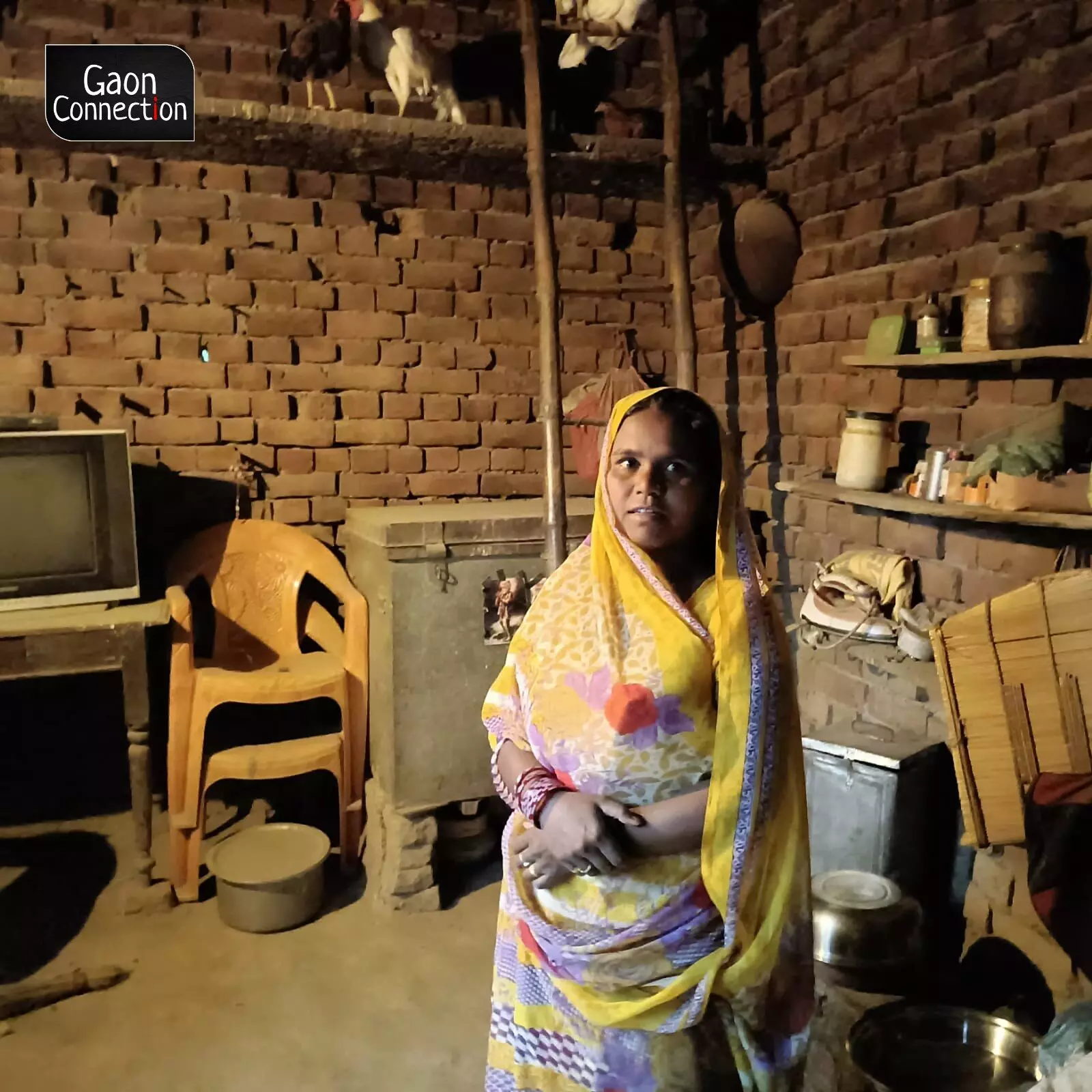
Rita Banwasi at her home in Varanasi. She gets 10 kg of rice and wheat every month under the Pradhan Mantri Garib Kalyan Anna Yojana. Photo by: Ankit Singh
However, the rural residents are worried as the central government has recently cut down the wheat quota under the Pradhan Mantri Garib Kalyan Anna Yojana (PMGKAY) that was launched by Prime Minister Narendra Modi in March 2020 in the aftermath of the COVID-19 pandemic as a massive public distribution of food grains for the poor.
Garib Kalyan Anna Yojana is aimed at providing 5 kg of free wheat or rice per person per month, along with one kg free whole chana per family per month. The scheme has been extended from time to time and is valid till September this year, and so far has benefitted 800 million beneficiaries in its four phases of implementation, claims the Indian government.
“The inflation in the last two months has worsened the situation,” said Dipa Sinha, assistant professor at Delhi’s Ambedkar University, who is also closely associated with The Right To Food Campaign.
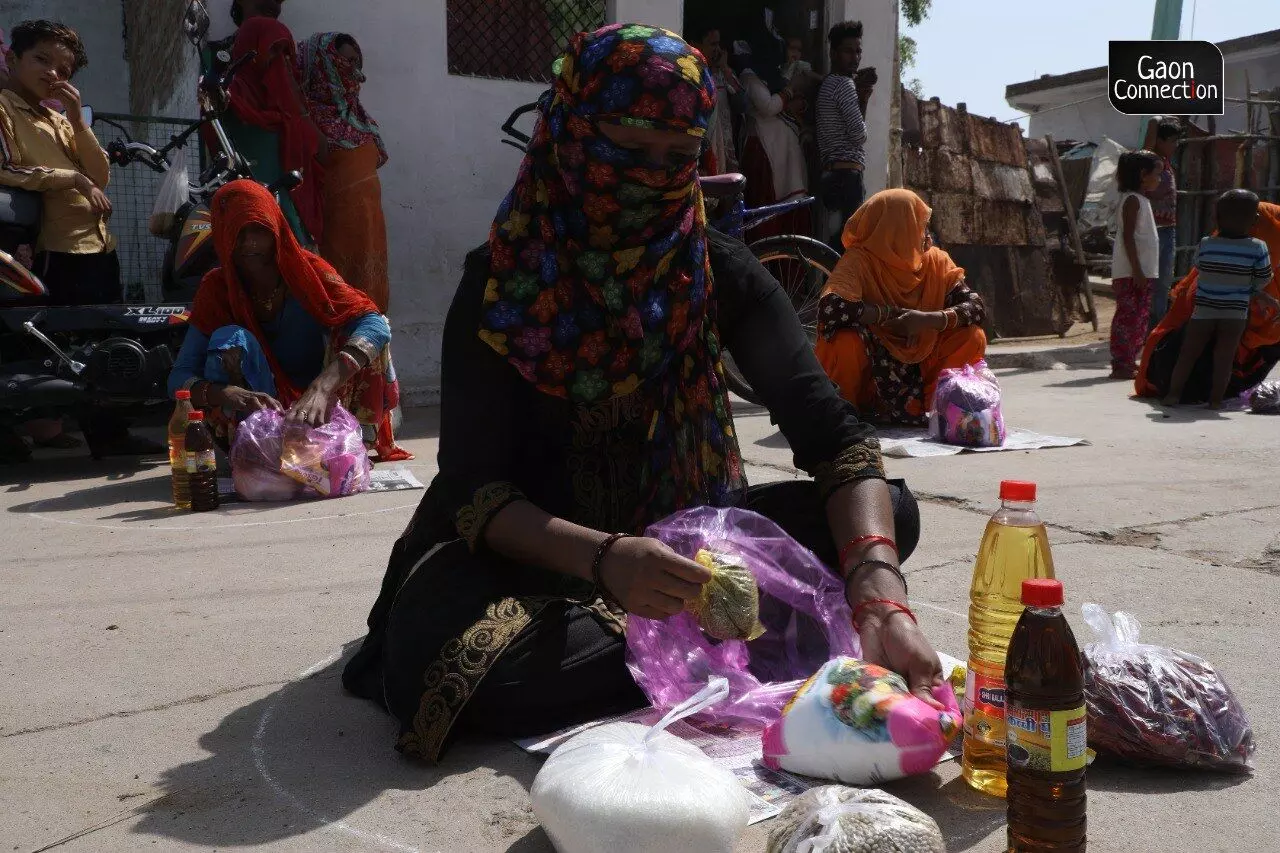
“Cereals are the least affected because under the PMGKAY grain distribution is still continuing, so those who have ration cards are at least getting something. But the prices of daal and oil are rising quite a bit which is leading to a fall in their consumption,” she added.
According to Sinha, the diets of people in rural India were already affected because of COVID19 and the economic slowdown has contributed towards reduction of consumption of more expensive food items such as daal, vegetables and eggs. She also feared that the PMGKAY may be discontinued due to the fears of wheat shortage in the country due to rising exports and low wheat production owing to the heatwaves.
The rising inflation has also affected the education of girls in rural households. Haryana’s Veena has three school-going children, out of which she said she can afford to educate only her sons while her daughter stays at home and helps her with household chores.
“On seeing the financial condition of the family, my daughter herself volunteered to drop out of school. Bhaiyo ki padhai zaada zaroori hai (My brothers’ education is more important than mine),” Veena told Gaon Connection.
Long-term health impacts
About eight in 10 surveyed Indian households have reported some form of food insecurity during the pandemic and an alarmingly high 25 per cent reported severe food insecurity, as per the Hunger Watch – II survey conducted by the Right to Food Campaign and the Centre for Equity Studies between December 2021 and January 2022.
The findings of the survey that were released on February 23 this year highlighted that a large proportion of households reportedly had not eaten nutritious foods more than twice or thrice a month. Only 27 per cent of the respondents reported eating eggs, flesh, milk, fruits and dark green leafy vegetables more than once a week.
“The development of the child between zero to three years dictates the lifelong consequences for the child so if there are key deficiencies in this age group, it would lead to both physical and mental deficiency later on,” warned Jain of CEEW India. “If the shedding of the food basket prolongs for long, these children could suffer from physical and mental conditions in their adulthood, limiting their productivity,” he warned.
According to the Union health ministry’s National Family Health Survey-5 (2020-21), while child nutrition indicators have slightly improved in rural India, anaemia continues to be a concern.
In rural India, 68.3 per cent of children in the age group of 6-59 months were found to be anaemic in 2020-21. This is an increase of 15 per cent in the past five years. During 2015-16, when the previous NFHS-4 was conducted, 59.5 per cent of children in that age group were found to be anaemic.
Strengthening PDS, crop diversification and kitchen gardens
According to Jain, there are no easy solutions to the rising inflation in the immediate run, especially if the PMGKAY gets suspended after September this year, which might force people to eat less.
“The reliance on the PDS system would still continue but the hunger index and actual nutrition deficiencies may get further pronounced if the inflation continues to remain high,” Jain said.
Sinha suggested that the government’s first priority should be to put all efforts to continue the welfare schemes and ensure grain distribution within the country.
“However, this shouldn’t come at the cost of the farmers. The government should buy wheat from the farmers at the market price. They are also losing out because of low yield,” Sinha said. She also recommended the addition of daal, chana and edible oil in the PDS system for the poor families.

As a medium-term solution, Jain said that there is a need to diversify our cropping patterns instead of relying only on rice and wheat. “Diversification should be a medium-term solution and kitchen gardens are a phenomenally effective solution. The kitchen garden will ensure that basic vegetables and micro-nutrients can be easily sourced by the household. Similarly, backyard poultry is another important intervention – these need to be intensified and scaled up further,” he suggested.
As a long term solution, Sinha said the Indian government should seek this opportunity to chalk out a plan to make the country less dependent on the import of oil and increase the production of edible oil.
With inputs from Ankit Singh (Varanasi, UP), Virendra Singh (Barabanki, UP) and Ramji Mishra (Sitapur, UP).

